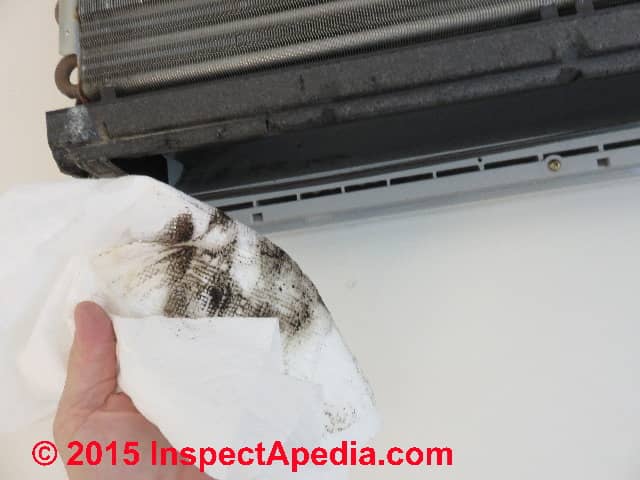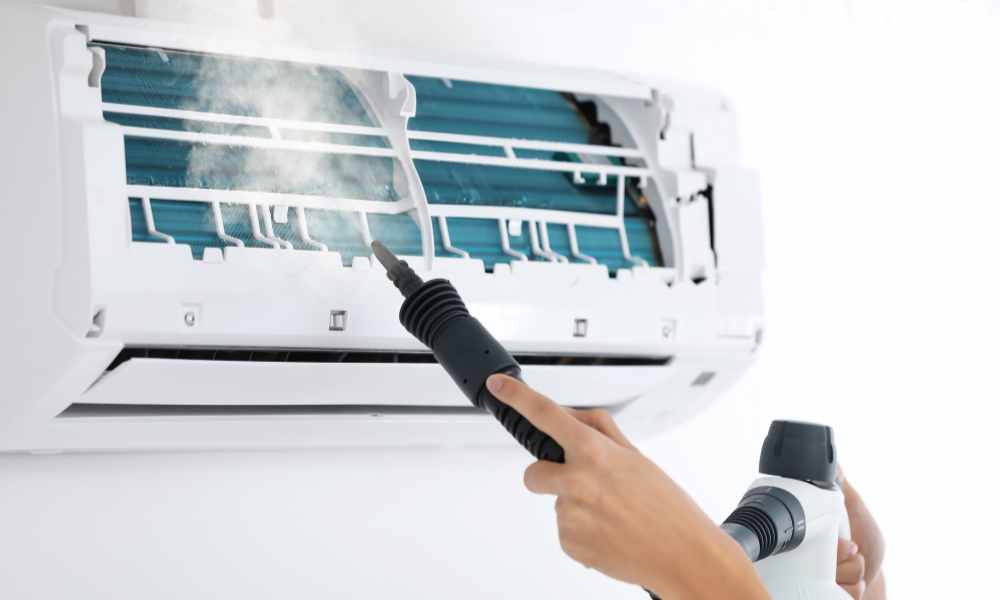How Do You Clean Mold Out Of An Air Conditioner

How to Clean Mold Out of Your Air Conditioner: A Comprehensive Guide
Mold growth in your air conditioner isn't just unpleasant; it can significantly impact your indoor air quality and the efficiency of your HVAC system. For homeowners, real estate investors, and contractors alike, understanding how to effectively clean mold from an AC unit is crucial for maintaining a healthy and functional living environment. This guide provides a detailed, step-by-step approach to removing mold and preventing its recurrence.
Why Mold Grows in Air Conditioners
Air conditioners provide the perfect breeding ground for mold: moisture, darkness, and often, a source of nutrients like dust and organic debris. When warm, humid air passes over the cold evaporator coils, condensation forms. This moisture, combined with the dirt that accumulates over time, creates an ideal environment for mold to thrive. Common areas for mold growth include the evaporator coils, drain pan, air ducts, and even the air filter.
Identifying Mold in Your Air Conditioner
Before you start cleaning, it's essential to identify if you actually have a mold problem. Common signs include:
- A musty or moldy odor coming from your vents.
- Visible mold growth on or around the air conditioning unit, especially near the coils or drain pan.
- Allergic reactions or respiratory issues experienced by occupants of the building.
If you suspect mold, a visual inspection is the first step. Use a flashlight to carefully examine the evaporator coils, drain pan, and nearby areas. If you find mold, proceed with the cleaning process outlined below. If the infestation is extensive or you are unsure about handling it yourself, it's best to consult a professional HVAC technician or mold remediation specialist.
Safety Precautions Before You Begin
Mold can trigger allergic reactions and respiratory problems in sensitive individuals. Therefore, it's crucial to take precautions before starting the cleaning process:
- Wear Protective Gear: Always wear gloves, a mask (N95 or higher), and eye protection to prevent inhaling mold spores or coming into contact with mold.
- Ventilate the Area: Open windows and doors to ensure adequate ventilation while you're working.
- Turn Off the Power: Disconnect the power supply to the air conditioner before beginning any cleaning. This is crucial to prevent electrical shock.
Tools and Materials You'll Need
Gather these supplies before you start:
- Gloves, mask, and eye protection
- Screwdriver or socket set to access the unit's components
- Soft brush or fin comb
- Vacuum cleaner with a HEPA filter
- Spray bottle
- Mold-killing solution (options include bleach solution, vinegar, or a commercially available mold cleaner)
- Clean cloths or paper towels
- Wet/dry vacuum (optional, for cleaning the drain pan)
Step-by-Step Guide to Cleaning Mold from Your Air Conditioner
Follow these steps to effectively clean mold from your air conditioner:
- Access the Evaporator Coils: Turn off the power to the air conditioner. Use a screwdriver or socket set to remove the access panel that covers the evaporator coils. The location of this panel varies depending on the type of AC unit. Consult your owner's manual if needed.
- Vacuum the Coils: Use a vacuum cleaner with a HEPA filter to remove loose dust and debris from the evaporator coils. This will make it easier to clean the mold.
- Clean the Coils with Mold-Killing Solution: Mix your chosen mold-killing solution according to the manufacturer's instructions or use one of the methods below:
- Bleach Solution: Mix 1 part bleach with 10 parts water.
- Vinegar: Use undiluted white vinegar.
Spray the solution onto the evaporator coils, ensuring that you cover all areas where mold is visible. Let the solution sit for about 10-15 minutes to kill the mold.
- Scrub the Coils Gently: Use a soft brush or fin comb to gently scrub the evaporator coils. Be careful not to damage the delicate fins. The goal is to remove the dead mold and any remaining debris.
- Rinse the Coils (Optional): If you used a bleach solution, you may want to rinse the coils with clean water to remove any residue. Use a spray bottle to lightly rinse the coils, avoiding excessive water.
- Clean the Drain Pan: The drain pan collects condensation from the evaporator coils and is a common breeding ground for mold. Remove the drain pan (if possible) and clean it thoroughly with the mold-killing solution. If the drain pan is not removable, use a wet/dry vacuum to remove any standing water and debris. Then, spray the drain pan with the solution and scrub it clean. Consider using drain pan tablets to prevent future mold growth.
- Clean the Air Filter: Replace or clean the air filter. A dirty air filter can contribute to mold growth and reduce the efficiency of your air conditioner. If you have a reusable filter, wash it with soap and water, allow it to dry completely, and then reinstall it.
- Reassemble the Unit: Once all the components are clean and dry, reassemble the air conditioner by replacing the access panel.
- Run the Air Conditioner: Turn the power back on and run the air conditioner. Monitor the unit for any unusual odors or noises.
Preventing Mold Growth in Your Air Conditioner
Preventing mold growth is always better than dealing with an infestation. Here are some tips to help keep your air conditioner mold-free:
- Regular Maintenance: Schedule regular maintenance for your air conditioner, including cleaning the coils, drain pan, and air filter.
- Change Air Filters Regularly: Replace your air filter every 1-3 months, or more often if you have pets or allergies.
- Keep the Area Around the Unit Clean: Remove any debris or clutter around the outdoor unit to ensure proper airflow.
- Address Moisture Issues: Fix any leaks or moisture problems in your home to reduce humidity levels. Consider using a dehumidifier in damp areas.
- Use UV Lights: Install a UV light inside your air handler to kill mold spores and bacteria. These lights can significantly reduce mold growth in your HVAC system.
- Professional Cleaning: Consider having your air conditioner professionally cleaned at least once a year.
When to Call a Professional
While you can often clean mold from your air conditioner yourself, there are situations where it's best to call a professional:
- Extensive Mold Growth: If the mold growth is widespread or difficult to reach, a professional HVAC technician or mold remediation specialist has the tools and expertise to handle the problem safely and effectively.
- Health Concerns: If you or someone in your household has severe allergies or respiratory problems, it's best to avoid cleaning mold yourself and let a professional handle it.
- Uncertainty: If you're not comfortable disassembling and cleaning your air conditioner, or if you're unsure about the type of mold you're dealing with, it's always best to consult a professional.
Air Conditioner Brands and Mold Prevention
While no air conditioner is completely immune to mold, some brands and models offer features that can help reduce the risk of mold growth. Consider these factors when choosing a new air conditioner:
- Coil Coatings: Look for air conditioners with antimicrobial coil coatings that inhibit mold growth.
- Self-Cleaning Features: Some models have self-cleaning functions that help remove moisture and debris from the coils.
- Advanced Filtration Systems: Air conditioners with high-efficiency filters can capture more dust and allergens, reducing the food source for mold.
Popular brands like Carrier, Trane, and Lennox offer models with these features. When comparing models, pay attention to their SEER (Seasonal Energy Efficiency Ratio) and EER (Energy Efficiency Ratio) ratings for cooling efficiency, and their HSPF (Heating Seasonal Performance Factor) rating if you are considering a heat pump. Higher ratings generally indicate greater energy efficiency and potentially better air quality.
For example, the Carrier Infinity Series offers models with advanced filtration systems and optional UV lights. Trane's TruComfort™ variable speed systems can maintain more consistent temperatures, reducing humidity and the risk of mold growth. Be sure to discuss mold prevention features with your HVAC dealer when making your purchase decision.
Warranty Considerations
Review your air conditioner's warranty to understand what is covered and what is not. Most warranties cover defects in materials and workmanship, but they may not cover mold growth resulting from improper maintenance. Regular maintenance and proper cleaning are essential to maintain your warranty coverage. Be sure to keep records of all maintenance performed on your air conditioner.
Conclusion
Cleaning mold out of your air conditioner is an important task for maintaining a healthy and efficient HVAC system. By following the steps outlined in this guide, you can effectively remove mold and prevent its recurrence. Remember to prioritize safety, use appropriate tools and materials, and consider calling a professional if you're unsure about any part of the process. With proper maintenance and preventative measures, you can enjoy clean, healthy air and a comfortable living environment.










